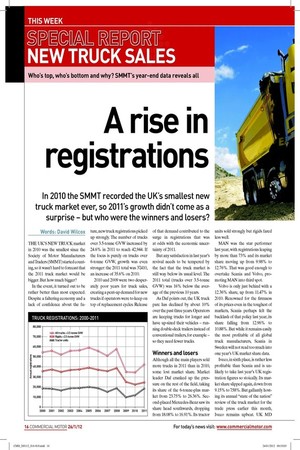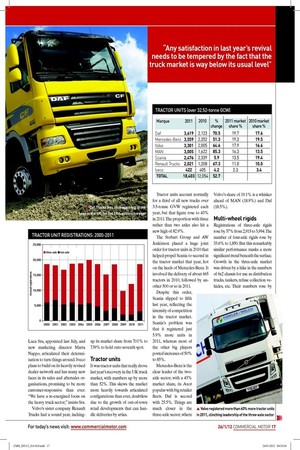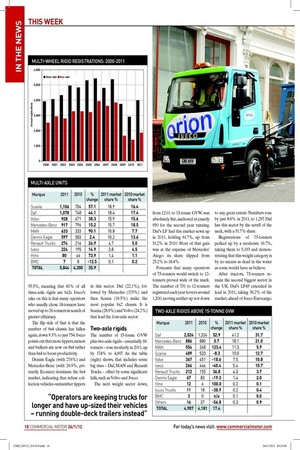NEW TRUCK SALES
Page 11

Page 12

Page 13

Page 14

If you've noticed an error in this article please click here to report it so we can fix it.
Who’s top, who’s bottom and why? SMMT’s year-end data reveals all
A rise
in registrations
In 2010 the SMMT recorded the UK’s smallest new truck market ever, so 2011’s growth didn’t come as a surprise – but who were the winners and losers?
Words: David Wilcox
THE UK’S NEW TRUCK market in 2010 was the smallest since the Society of Motor Manufacturers and Traders (SMMT) started counting, so it wasn’t hard to forecast that the 2011 truck market would be bigger. But how much bigger?
In the event, it turned out to be rather better than most expected. Despite a faltering economy and a lack of conidence about the fu
ture, new truck registrations picked up strongly. The number of trucks over 3.5-tonne GVW increased by 24.6% in 2011 to reach 42,944. If the focus is purely on trucks over 6-tonne GVW, growth was even stronger: the 2011 total was 37,410, an increase of 35.6% on 2010.
2010 and 2009 were two desperately poor years for truck sales, creating a pent-up demand for new trucks if operators were to keep on top of replacement cycles. Release of that demand contributed to the surge in registrations that was at odds with the economic uncertainty of 2011.
But any satisfaction in last year’s revival needs to be tempered by the fact that the truck market is still way below its usual level. The 2011 total (trucks over 3.5-tonne GVW) was 16% below the average of the previous 10 years.
As Daf points out, the UK truck parc has declined by about 10% over the past three years. Operators are keeping trucks for longer and have up-sized their vehicles – running double-deck trailers instead of conventional trailers, for example – so they need fewer trucks.
Winners and losers
Although all the main players sold more trucks in 2011 than in 2010, some lost market share. Market leader Daf cranked up the pressure on the rest of the ield, taking its share of the 6-tonne-plus market from 23.75% to 26.36%. Second-placed Mercedes-Benz saw its share head southwards, dropping from 18.08% to 16.91%. Its tractor units sold strongly but rigids fared less well.
MAN was the star performer last year, with registrations leaping by more than 73% and its market share moving up from 9.98% to 12.76%. That was good enough to overtake Scania and Volvo, promoting MAN into third spot.
Volvo is only just behind with a 12.36% share, up from 11.47% in 2010. Renowned for the irmness of its prices even in the toughest of markets, Scania perhaps felt the backlash of that policy last year, its share falling from 12.96% to 10.88%. But while it remains easily the most proitable of all global truck manufacturers, Scania in Sweden will not read too much into one year’s UK market share data.
Iveco, in sixth place, is rather less proitable than Scania and is unlikely to take last year’s UK registration igures so stoically. Its market share slipped again, down from 9.15% to 7.58%. But gallantly hosting its annual “state of the nation” review of the truck market for the trade press earlier this month, Iveco remains upbeat. UK MD Luca Sra, appointed last July, and new marketing director Marta Nappo, articulated their determination to turn things around. Iveco plans to build on its heavily revised dealer network and has many new faces in its sales and aftersales organisations, promising to be more customer-responsive than ever. “We have a re-energised focus on the heavy truck sector,” insists Sra.
Volvo’s sister company Renault Trucks had a sound year, inching up its market share from 7.01% to 7.39% to hold onto seventh spot.
Tractor units
It was tractor units that really drove last year’s recovery in the UK truck market, with numbers up by more than 52%. This skews the market more heavily towards articulated conigurations than ever, doubtless due to the growth of out-of-town retail developments that can handle deliveries by artics. Tractor units account normally for a third of all new trucks over 3.5-tonne GVW registered each year, but that igure rose to 43% in 2011. The proportion with three rather than two axles also hit a new high of 82.9%.
The Stobart Group and AW Jenkinson placed a huge joint order for tractor units in 2010 that helped propel Scania to second in the tractor market that year, hot on the heels of Mercedes-Benz. It involved the delivery of about 665 tractors in 2010, followed by another 500 or so in 2011.
Despite this order, Scania slipped to ifth last year, relecting the intensity of competition in the tractor market. Scania’s problem was that it registered just 5.9% more units in 2011, whereas most of the other big players posted increases of 50% to 85%.
Mercedes-Benz is the clear leader of the twoaxle sector, with a 43% market share, its Axor popular with big retailer leets. Daf is second with 25.5%. Things are much closer in the three-axle sector, where Volvo’s share of 19.1% is a whisker ahead of MAN (18.9%) and Daf (18.5%).
Multi-wheel rigids
Registrations of three-axle rigids rose by 37% from 2,915 to 3,994. The number of four-axle rigids rose by 33.6% to 1,850. But this remarkably similar performance masks a more signiicant trend beneath the surface. Growth in the three-axle market was driven by a hike in the numbers of 6x2 chassis for use as distribution trucks, tankers, refuse collection vehicles, etc. Their numbers rose by 55.5%, meaning that 81% of all three-axle rigids are 6x2s. Iveco’s take on this is that many operators who usually chose 18-tonners have moved up to 26-tonners in search of greater eficiency.
The lip side of that is that the number of 6x4 chassis has fallen again, down 9.3% to just 754. Iveco points out that more tippers, mixers and bulkers are now on 8x4 rather than 6x4 to boost productivity.
Dennis Eagle (with 27.6%) and Mercedes-Benz (with 26.9%, primarily Econics) dominate the 6x4 market, indicating that refuse collection vehicles outnumber tippers in this sector. Daf (22.1%), followed by Mercedes (17.5%) and then Scania (16.5%) make the most popular 6x2 chassis. It is Scania (28.9%) and Volvo (24.2%) that lead the four-axle sector.
Two-axle rigids
The number of 15-tonne GVW plus two-axle rigids – essentially 18tonners – rose modestly in 2011, up by 17.4% to 4,907. As the table (right) shows, that includes some big rises – Daf, MAN and Renault Trucks – offset by some signiicant falls, such as Volvo and Iveco.
The next weight sector down, from 12.01 to 15-tonne GVW, was absolutely lat, anchored at exactly 950 for the second year running. Daf’s LF had this market sewn up in 2011, holding 61.7%, up from 51.2% in 2010. Most of that gain was at the expense of Mercedes’ Atego: its share slipped from 25.2% to 18.4%.
Forecasts that many operators of 7.5-tonners would switch to 12tonners proved wide of the mark. The number of 7.51 to 12-tonners registered each year hovers around 1,200, moving neither up nor down to any great extent. Numbers rose by just 8.6% in 2011, to 1,297. Daf has this sector by the scruff of the neck, with a 51.7% share.
Registrations of 7.5-tonners perked up by a moderate 16.7%, taking them to 5,193 and demonstrating that this weight category is by no means as dead in the water as some would have us believe.
After tractors, 7.5-tonners remain the second biggest sector in the UK. Daf’s LF45 extended its lead in 2011, taking 36.2% of the market, ahead of Iveco Eurocargo. The two lightweight Japanese contenders, Isuzu Trucks’ N75 and Fuso’s Canter, have made rapid progress in recent years but both lost a little market share in 2011, doubtless affected by the squeeze on local authority budgets.
But things were no better for the two German 7.5-tonners, Mercedes’ Atego and MAN’s
TGL, both at the heavier end of the scale. The Atego’s market share slipped to 11.6%, equalling its lowest since the model was launched in 1998. MAN’s 6.8% market share was its lowest for more than a decade. ■
What lies ahead
On one hand, the UK economy is believed to be on the brink of recession. On the other, there is an urgency to pull forward truck purchases before Euro-6 emission limits arrive on the 31 December 2013, making trucks far more expensive.
So which will prove the dominant force as far as new truck sales are concerned in the next year or so? The SMMT’s view, articulated by chief executive Paul Everitt, is for “a broadly flat year” in 2012. Daf expects the 6-tonne-plus truck market to increase by about 5%. “There is so much uncertainty about the economy that it is unwise to make any forecasts,” says Iveco’s Sra.
There is consensus that truck sales will spike in 2013 in the scramble to beat the Euro-6 deadline at the end of the year. That will be a Europe-wide spike so we can expect delivery lead times to stretch out into the far distance again, just like they did in 2007 when demand boomed in eastern Europe.
Maybe some of those late deliveries will fall into 2014, when they will make a welcome boost for the registration figures. Orders for the first Euro-6 trucks are bound to be sparse, so 2014 will be tough for truck sales executives.











































